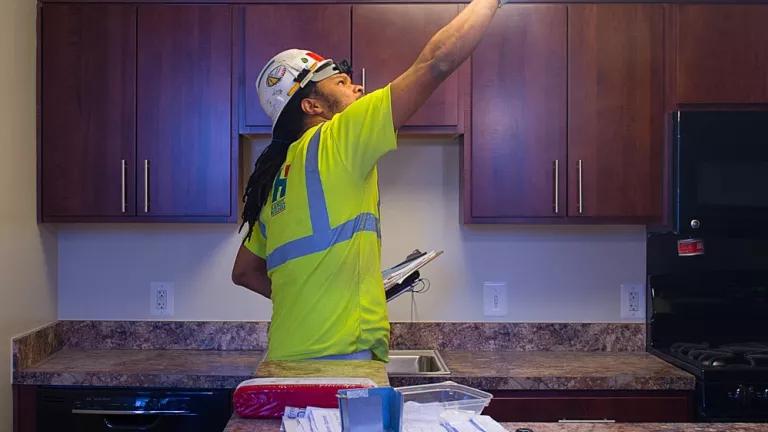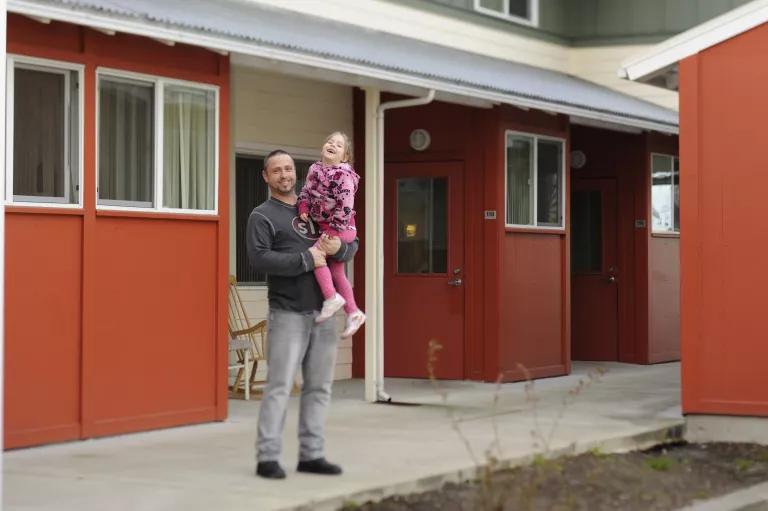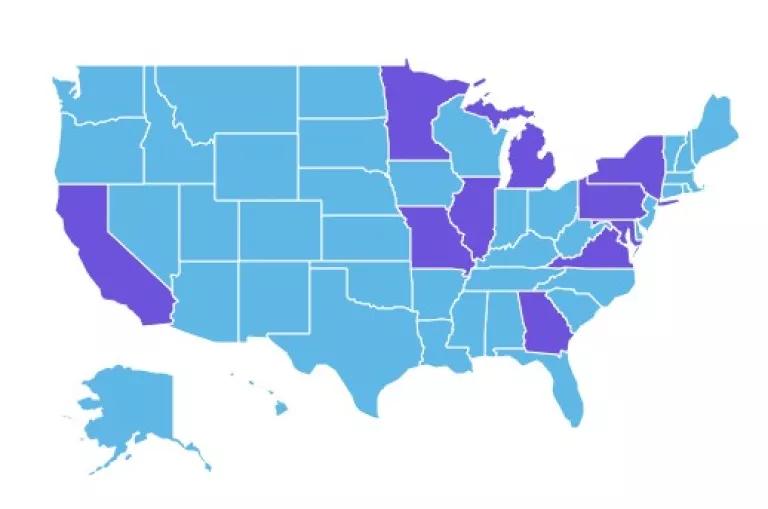New and Improved Energy Efficiency Programs

Access Resources Now to Upgrade Multifamily Homes in 10 States
This blog was written in partnership with Becky Schaaf and Tawe Wongbuphanimitr of Stewards of Affordable Housing for the Future
Opportunity
Utility programs are a valuable and growing resource to the affordable housing community. According to ACEEE’s 2018 State Energy Efficiency Scorecard, utilities across the U.S. dedicated $7.9 billion to energy efficiency programs in 2017 alone. Likewise, utility investments designated for affordable multifamily programs have grown significantly over the past five years, and the gap between affordable multifamily’s share of the residential market and their share of utility residential investment is beginning to close in many states. These programs provide the access to the technical and financial assistance that owners need to make smart investments in their properties—investments that will reduce both owner operating costs and resident energy burdens. Owners who are taking advantage of these resources are seeing results. For example, over the past 5 years the non-profit affordable housing providers who are members of Stewards for Affordable Housing for the Future (SAHF) have received an average of $750/unit in utility incentives and are seeing annual utility bill savings of more than $125/unit at properties that have participated in utility programs. However, there is still a very significant amount of untapped savings potential in the affordable multifamily sector. The Potential for Energy Savings report indicates the significant opportunity and potential for the expansion of energy efficiency, demonstrating an estimated $16 billion in savings available in multifamily buildings nationwide.
Barriers
Two critical barriers that prevent multifamily affordable housing owners from getting the most out of available efficiency programs are programs that are often not well-designed leading to unintended obstacles in participation or the achievement of deeper efficiency savings, and the fact that affordable housing owners face many competing priorities for their time and have limited bandwidth to dedicate to program participation.
The Energy Efficiency for All (EEFA) Initiative and Stewards of Affordable Housing for the Future (SAHF) have teamed up to tackle both barriers. Since 2013, EEFA has been advocating for more and better efficiency programs to serve multifamily affordable housing and has secured nearly $500M in estimated and confirmed additional funding along with new programs and program design improvements of existing programs. In 2018, SAHF and EEFA compiled descriptions of 19 programs in 10 states to ensure owners are informed about these new and improved programs. The descriptions include critical information that owners need to effectively use the programs to decrease their operating costs and reduce the energy burdens of their residents. The descriptions demonstrate the value of these programs and make it easy for owners to participate by providing practical information on eligibility, energy efficiency measures, and accessible step-by-step instructions on how to these programs can support capital improvements and result in better building performance.
Benefits
These new and improved energy programs allow building owners and customers to access millions of dollars in energy savings and realize the myriad of benefits that accrue from investments in efficiency. Efficiency increases the long-term viability of affordable housing by reducing operating costs which can offset potential rent increases or go toward other capital needs. Energy savings are ongoing, providing greater return on investment for the owner. For residents, lower utility bills improve energy security and help residents meet other needs. Retrofits also improve the health, safety, and comfort of the building for residents by improving indoor air quality and providing more reliable temperatures. Residents living in apartments with better ventilation, climate control, lighting, and overall environmental quality have measurably better physical and mental health outcomes as well as overall quality of life. Improved housing conditions may prompt residents to remain in a building longer, leading to stability for renters and owners alike. Last but not least, the retrofits create public benefits such as new, clean energy jobs and reduced pollution from energy production.

Program Types
The programs described by SAHF provide energy efficiency upgrades that fall into three main categories: 1) whole building retrofits; 2) direct installation of efficient appliances; and 3) prescriptive and custom incentives, or product rebates. Some offerings fall into more than one category or provide multiple efficiency options for building owners.
- Whole building programs focus on comprehensive energy savings by assessing potential building upgrades holistically. Examples of such programs include California’s Low-Income Weatherization Program, the New York State Energy Research and Development Authority’s (NYSERDA) Multifamily Performance Program, and CenterPoint Energy and Xcel Energy’s Multifamily Building Efficiency Program in Minnesota. In Minnesota, case examples highlighted by the Minnesota Sustainable Housing Initiative, have already been able to highlight the impact of the whole building approach on reducing energy and operation costs, improving resident health and comfort, and enhancing the ability of the state to preserve its affordable housing stock.
- Direct install programs allow for the replacement of inefficient appliances with more efficient counterparts. For example, in Pennsylvania, the PECO Smart Multifamily Solutions Program offers building owners direct installation measures for lighting and water efficiency measures in common areas and units. In addition, the properties are also assessed for potential energy savings.
- Prescriptive programs offer financial contributions for standard energy efficiency projects like HVAC or lighting upgrades. Programs may offer custom financial incentives for more complex projects. Programs that provide for these types of incentives include the Consumers Energy Multifamily Program in Michigan and the ComEd Low-Income Multifamily Program in Illinois. In Illinois, for instance, owners receive opportunities to cost effectively improve their HVAC systems and install efficient light bulbs or appliances. Furthermore, building owners can apply for custom incentives to save money on upgrades such as an improved refrigeration system or other innovative ideas that improve energy efficiency. Prescriptive incentives often work best in conjunction with other methods for saving and in Illinois owners can access energy assessments, direct-install, and prescription and custom incentives in a one-stop shop.
Advantages of Well-Designed Efficiency Programs
Together, these energy programs demonstrate program design features that better meet the needs of multifamily owners and residents while fostering greater participation.
- The rebates, incentives, financing programs, and free measures provided by utility programs are crucial because they help address the reality that affordable housing properties run on tight budgets with limited reserves to pay for a wide variety of building upgrades, not just energy efficiency. These financial resources help owners invest in their properties without disturbing the complex capital stacks and ownerships structures that can prevent owners from taking on debt to cover the cost of upgrades.
- Free or highly subsidized measures for residents also help address one of the biggest barriers to efficiency in rental properties—the split incentive.
- Whole-building incentives based on energy savings thresholds encourage deeper retrofits and help owners make more cost-effective investments and realize greater energy reductions.
- One-stop-shops or technical assistance also help overcome the issue of owners’ scarce capacity to manage retrofits. By coordinating services, owners have a single point of contact to get questions answered and problems solved.
- Programs that are designed to account for multifamily-specific complexities such as common area and in-unit measures or metering configuration make it much easier for owners to participate.
- And the set of program descriptions produced by EEFA and SAHF helps address a final barrier to implementing efficiency—a general lack of information!
Testimonial
“The Maryland MEEHA EmPOWER Energy Grant Program is a wonderful resource and tool that Homes for America has used to make tremendous improvements in terms of energy efficiency in our communities.
“Without MEEHA, the cost alone would have prevented us from pursuing these upgrades. Through MEEHA, several measures were covered in full and additional items were able to be cost shared, allowing us to maximize the potential savings for our residents. From the energy audit to the installation, DHCD made the process simple for us to ensure savings were being realized at the three communities that have received grants to date (Homes at Foxfield, Parkside Apartments and The Bradford). The retrofits lowered the workload of our maintenance staff and energy bills for our tenants. We plan to continue to utilize the MEEHA grant program at several of our properties in the future to achieve our mission of providing great housing for our low-income residents.”
—Frank Fudala, Vice President, Portfolio Management, Homes for America
Call to Action
There are many great programs that owners can take advantage of today and utilities across the country continue to expand and improve their affordable multifamily programs. We hope that this expanding portfolio of programs will serve as models to other utilities to better serve the affordable multifamily sector and that robust participation in current programs will drive increased investment in the sector. In partnership, utilities and owners have the potential to bring to fruition the many benefits of energy efficiency, from reduced energy bills to less reliance on fossil fuels, resulting in greater financial stability and higher quality of life for renters.
Visit Stewards of Affordable Housing for the Future to learn how to take advantage of the energy efficiency programs in the following states:

Map of states with new and improved energy efficiency programs:
California, Georgia, Illinois, Maryland, Michigan, Minnesota, Missouri, New York, Pennsylvania, Virginia
About Stewards of Affordable Housing for the Future (SAHF)
SAHF is a nonprofit collaborative of thirteen exemplary multi-state nonprofit affordable housing providers who own more than 138,000 affordable rental homes. SAHF’s mission is to lead policy innovation and advance excellence in the delivery of affordable rental homes that expand opportunity and promote dignity for residents. Launched in 2003, SAHF’s members came together to promote their shared ownership objectives, which embraces the notion that stable, affordable, service-enriched housing is critically important in the lives of all people. For more information, visit www.sahfnet.org.
Energy Efficiency for All, or EEFA, was launched in 2014 by Elevate Energy, the Energy Foundation, the National Housing Trust, and the Natural Resources Defense Council to bring the benefits of energy efficient, healthy, and affordable homes to the millions living in multifamily rental housing. We do this by uniting people from diverse sectors and backgrounds to work together to overcome the barriers to making affordable multifamily housing and energy and water efficient. For more information, visit. www.energyefficiencyforall.org.




